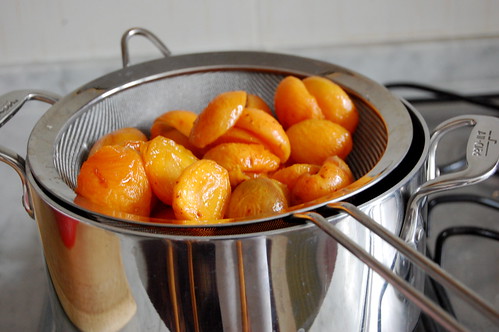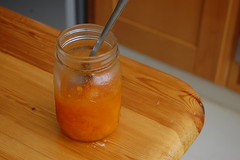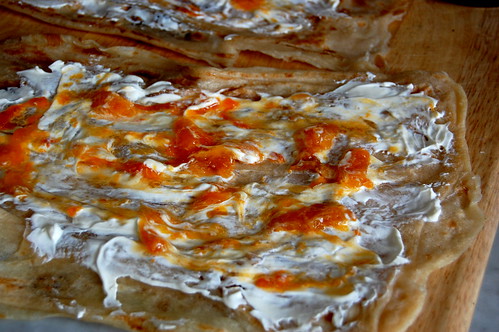
Apricot jam is, in my mind, the pinnacle of jams. Some people may like raspberry or current or strawberry (ick), but really, my favorite is apricot. The apricot season is so short and fleeting, and even shorter is the season when apricots are really good and juicy, because about two of the three weeks of apricot season are filled with cottony-dry and bruised over-ripe apricots (for those, roasting is the way to go). But with jam, you can have apricots all year round.
This year, I set out to make the apricot jam from Christine Ferber's book of recipes. At about every stage in making this jam, I was sure I had failed and ruined the whole batch. First my apricots discolored in the fridge, then they wouldn't peel, then the jam seemed too runny. But I just kept on going, and what I got was about the best jam I have ever made. Seriously.


Though the recipe seems like it has many steps, it is actually a very quick jam to make. If you thought making jam was all about stewing fruit for hours, Mme Ferber is here to change your mind. By keeping the cooking time relatively short, the apricots stay bright and fresh tasting. I've added additional tips and pointers in the recipe based on my experience. File this away for next apricot season and I promise it will be worth the effort. As the French would say, bon courage!

Apricot Jam
At several points in this recipe you will probably think you've gone terribly wrong. Just keep going! Trust your instincts, and it will come out great in the end. If your apricots discolor when resting in the fridge don't worry, the boiling with take away any brown edges. Though the recipe seems long and involved it really only take a total of about 30 minutes of kitchen time. Makes about 4 jars.
1 kilo firm-ripe apricots (2.2 pounds)
700 grams sugar (24 5/8 ounces, or 3 cups plus 2 tbl)
175 grams water (6 1/8 ounces, 3/4 cup)
juice of 1 large lemon, or 1 1/2 regular-sized lemons
1. Halve and pit the apricots, placing apricot halves in a large, preferably ceramic, bowl. Place the bowl on your scale, set scale to zero, and then add your sugar and water using the weight measurements on your scale. Add the lemon juice, stir everything to combine. Cover the bowl with parchment paper, a towel, or plastic wrap, and set in the fridge for 6-8 hours.
2. Pour all the contents of the bowl into a pan and bring to a simmer. When the mixture is fully simmering, let simmer for about 5 minutes, then turn off the heat and pour the mixture back into the ceramic bowl. Cover again and set in the fridge overnight.
3. Place a small plate in the freezer. Strain the apricot mixture, emptying the juices into a pan. If your apricots skins are loose, peel them off. If your apricot skins are not loose, do not try to kill yourself trying to peel them off and simply proceed with the skins on. Your jam will be a bit more rustic but really it's barely noticeable.
4. Bring the juice in the pan to a boil. Skim off any foam that accumulates on the top of the liquid. Boil the juice for a good 8-10 minutes, or until it is thickened and reaches 221 F (105 C) on a candy thermometer. (Since you may have more or less liquid depending on the juiciness of your apricots, the timing can vary, so a thermometer is a good gauge).
5. Add in the apricots and boil on high for another 3-5 minutes, continuing to skim. It will seem like you have too much liquid to apricot ratio, but don't worry. The apricots should start to fall apart around the edges and gel with the liquid, but should overall retain their shape. You can test the jam by adding a spoonful to your frozen plate and seeing if it gels up quickly*. Otherwise, about a five minute boil should do it. Ladle into clean jam jars and seal as desired.
* For more on the freezer jam test see here.
For labane and apricot roll-ups, pictured below, take a sheet of lavash, pita, marquq, or other flat bread. Spread the bread with some labane, strained yogurt, or just some thick Greek yogurt. Spread with apricot jam, roll-up, and this is a great breakfast on the go. You can make them ahead of time too.







8 comments:
Apricot jam would also be good with a double cream brie. Cut the brie in layers and sandwich the jam between the layers. Heaven!
I started this yesterday morning and just finished -- I already have some lavash lying around and am SO looking forward to tomorrow's breakfast!
Excellent!
Our apricots come into season around the start of May, so my boys purchase a case (or two) as a Mother's Day present each year. In recent years, I've been complaining it is getting to be too much work, what with all the peeling and chopping (I use the Blue Book recipe). This recipe sounds perfect-The sit in the fridge eliminates all the need for finely chopped fruit.
Thank you so much for posting this-I can't wait until next spring.
After reading this post I couldn't get those wraps out of my mind, so today I finally went to my local Middle Eastern grocer and got some Sabayad bread, which I believe is a Somalian bread, (we have a large Somali population here in Minneapolis). Spread with some thick greek yogurt and raspberry jam I made earlier this year; it was the perfect mid-day pick me up with a cup of coffee. Thank you for posting this!
Hi Emalie, glad you liked it! I've never heard of sabayad bread but sounds interesting!
Last week I made a double batch of this apricot jam because I was so sad when I ran out in the middle of last winter. It's even better than I remembered it being!
Nzle - funny, I was just staring at a pile of apricots wondering what to make with them. Your comment was my reminder!
Post a Comment